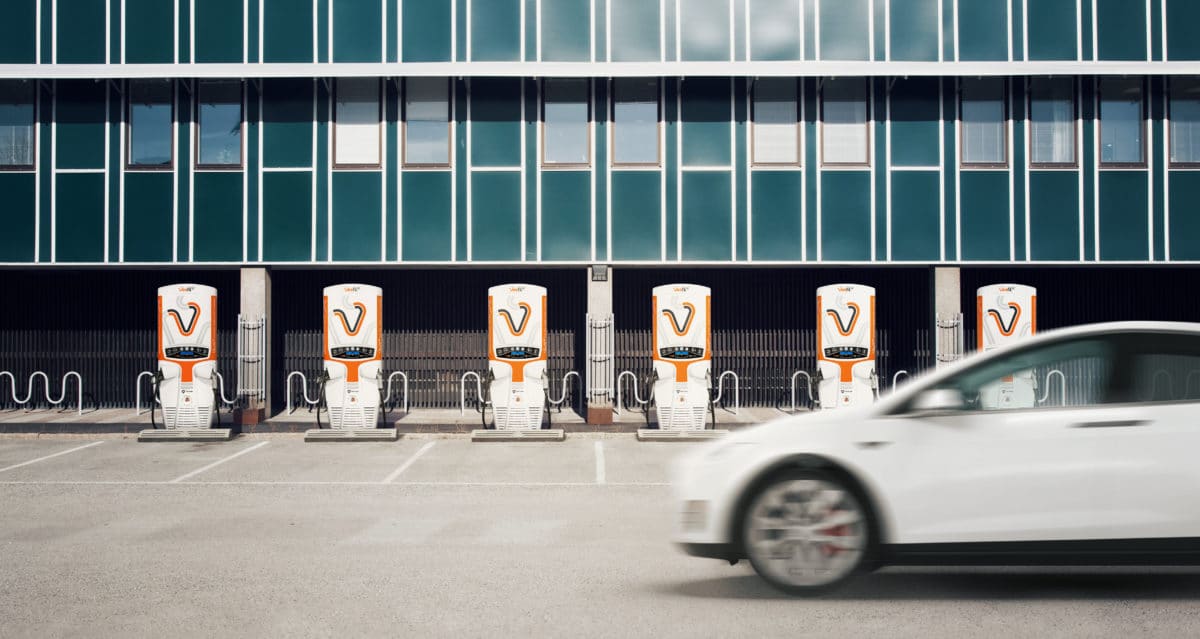By James Kennedy
 Electric vehicle owners may not realize that their cars could be an energy asset by charging at one location, storing excess energy, and then delivering it back to the grid when and where it’s needed. While EVs today only import electricity, and EV charging stations only send electricity to vehicles, EVs enabled with vehicle-to-grid (V2G) technology could feed electricity from their batteries to the grid using bidirectional charging stations. Once this emerging technology is widely available, EV owners will be able to use it to power their homes or sell excess energy to utilities—and enable fully renewable grids.
Electric vehicle owners may not realize that their cars could be an energy asset by charging at one location, storing excess energy, and then delivering it back to the grid when and where it’s needed. While EVs today only import electricity, and EV charging stations only send electricity to vehicles, EVs enabled with vehicle-to-grid (V2G) technology could feed electricity from their batteries to the grid using bidirectional charging stations. Once this emerging technology is widely available, EV owners will be able to use it to power their homes or sell excess energy to utilities—and enable fully renewable grids.
Powered by the pedal
As a whole, EVs form a fleet that can already store surplus grid energy from intermittent renewable resources like solar and wind. This relies on the vehicles being connected to the grid most of the time, both at home and at work. Whenever the wind blows or the sun shines, there is a guaranteed group of customers to purchase the energy. Using V2G technology, EV owners could power their homes with energy stored in their car batteries.
EVs have more capacity than they need on a regular basis: the average U.S. driver travels about 30 miles daily in their vehicle, while most EVs have a range of several hundred miles. And despite some car owners’ concerns, discharging the battery won’t have any significant impact on its useful life, because a typical battery already outlasts the vehicle. Current vehicles with a 200-mile range on a 60kW battery pack could run a typical house, including air conditioning, for four to five days.
That’s handy in an emergency situation, but the real opportunity is selling energy back to utilities, balancing renewable production with energy demand. Using rates that change in real time, utilities could encourage EV owners to charge up during the day when there is excess (and therefore cheap) solar energy on the grid and sell the power back during the evening peak.
EV owners would charge their vehicles using a fast charger at work or a soon-to-come high-powered charger (Tritium has an up-to-475kW unit in action in Europe) while out shopping, and then drive home and plug the car into their home charger. As demand for energy ramps up in the evening, the utility could purchase power from full EV batteries. Contracted limits would leave plenty of power in the vehicles, which could be topped up the next day. Meanwhile, drivers would earn more from selling their battery power than they paid for it.
Incentives drive adoption
Utilities hold the key to unlocking EV-to-grid capabilities, and there’s ample reason for them to use it. Within the next several years, bidirectional charging could unlock a 100 percent renewably powered grid—without any coal, nuclear, or gas storage baseload—by balancing peaks and valleys in renewable energy.
Another motivator is the need to retain customers. Once home batteries coupled with rooftop solar become widely accessible, a large number of EV owners may choose to leave the grid in favor of powering their homes with a combination of solar energy and battery storage, with the car battery available to cover any shortfall.
Incentivizing EV drivers to sell power back to the grid is the way to keep them hooked up. If utilities make it financially attractive, drivers will give them access to all those big mobile battery packs when the sun isn’t shining. Most likely this means demand response using a real-time pricing signal, possibly targeted at whatever transformer the driver is connected to. If the incentives are right, drivers will be better off selling power back to the grid and charging according to grid needs than using their EV to top off their home battery.
Price signals that encourage EVs to charge and discharge at optimal times also will help utilities avoid strain on the grid from the growing EV population. Owning an EV will increase household electricity consumption by about 50 percent, according to a new study by LEK Consulting and Tritium. And with a predicted 125 million EVs on the road by 2030, the number of charging stations required by 2030 will top 130 million units (about 30 times the current base).
Using EVs to help balance the grid, instead of simply demanding more from it, should be an easy choice for drivers and utilities. When we connect EVs to the grid, a brave new (renewably powered) world for low-emission transportation and power will come into view.
James Kennedy, engineering director and co-founder of Tritium, runs the company’s research and development team. An expert in battery management and high-power electronics, James draws on more than 15 years of experience in embedded systems and power electronics design and manufacturing. He was a member of the Sunshark solar car racing team that formed in 1999, and helped develop Tritium’s first motor driver product.
The views and opinions expressed in this article are the author’s own, and do not necessarily reflect those held by pv magazine.
This content is protected by copyright and may not be reused. If you want to cooperate with us and would like to reuse some of our content, please contact: editors@pv-magazine.com.








By submitting this form you agree to pv magazine using your data for the purposes of publishing your comment.
Your personal data will only be disclosed or otherwise transmitted to third parties for the purposes of spam filtering or if this is necessary for technical maintenance of the website. Any other transfer to third parties will not take place unless this is justified on the basis of applicable data protection regulations or if pv magazine is legally obliged to do so.
You may revoke this consent at any time with effect for the future, in which case your personal data will be deleted immediately. Otherwise, your data will be deleted if pv magazine has processed your request or the purpose of data storage is fulfilled.
Further information on data privacy can be found in our Data Protection Policy.